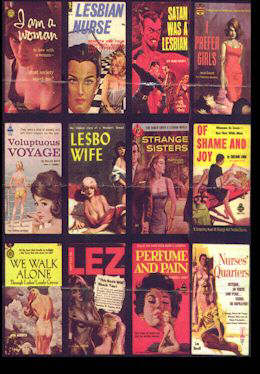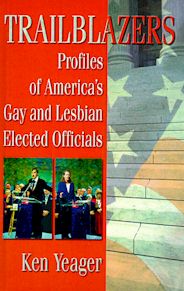 |


|
|
Trailblazers: Profiles of America's Gay and Lesbian Elected Officials Strange Sisters: The Art of Lesbian Pulp Fiction 1949-1969 by Jaye Zimet; with a Foreword by Ann Bannon; Viking Studio; 160 pages; $19.95.
 When mass market paperbacks first appeared in the 1940's, hopeful critics
hoped that it would spread literature to the masses. Instead, the
"paperback revolution" resulted in a world-wide dissemination of trash.
When mass market paperbacks first appeared in the 1940's, hopeful critics
hoped that it would spread literature to the masses. Instead, the
"paperback revolution" resulted in a world-wide dissemination of trash.
One of the most popular pulp paperback topics was lesbianism; not the liberated lesbianism of today but the "twisted passions" of "odd girls" and "twilight lovers". Though most of those potboilers were written by and for straight men, a few of them (the better ones), were written by women: Valerie Taylor, Paula Christian, Ann Bannon, Patricia Highsmith (as Claire Morgan), Marion Zimmer Bradley (as Lee Chapman or Miriam Gardner), and Marijane Meaker (as Ann Aldrich or Vin Packer), just to name a few. Out of these pearls in a dunghill emerged today's lesbiana. Though most lesbian pulps are worthless rubbish, their sleazy covers have a camp appeal that withstood the test of time. Jaye Zimet, "an avid collector of vintage lesbiana," shares her stash with us in Strange Sisters: The Art of Lesbian Pulp Fiction 1949-1969.
For one thing, lesbians were not just "lesbians". They were "degraded women", "queer sisters" or "warped women" who sought "the path between" in order to satisfy their "raging needs". They could be "dormitory women", "the girls in 3-b", "reformatory girls," career women - a "woman doctor" or a "lesbian nurse" - or even a "lesbo wife". They were found not only on "queer beach" or on "21 Gay Street", but also in prisons, "girls' dormitories", "nurses' quarters" and "women's barracks". But most of all they were strange: "strange sisters", "strange friends" and "strange women" with "strange passions" and "strange delights".
 Though the titles are suggestive enough by themselves,
together with the covers they give us a collective view of lesbianism that
surely had nothing to do with lesbian life as it existed then (or now) but
which tells us a lot about the people who wrote and published such crap.
Though the titles are suggestive enough by themselves,
together with the covers they give us a collective view of lesbianism that
surely had nothing to do with lesbian life as it existed then (or now) but
which tells us a lot about the people who wrote and published such crap.
Though their obvious goal was to titillate straight men, lesbian pulps were to gay women what physique magazines were to gay men: they validated their desires and proved that they were not "the only ones." Though most pulps ended in death or heterosexuality, the better ones among them (see above) showed that women could find love and happiness with other women. In their day, the pulps were the only ones of their kind. Today, we can look back with fondness and nostalgia and appreciate the pulps for what they were. Those who are too young to remember the pulps can look at the covers in Strange Sisters and see just what they missed. Trailblazers: Profiles of America's Gay and Lesbian Elected Officials by Kean Yeager; The Haworth Press; 269 pages; $29.95.
 Trailblazers: Profiles of America's Gay and Lesbian Elected Officials won
the first-ever Victory Fund Award for books that promote the Victory
Fund's goal of electing openly queer candidates. Ken Yeager certainly
practices what he preaches.
Trailblazers: Profiles of America's Gay and Lesbian Elected Officials won
the first-ever Victory Fund Award for books that promote the Victory
Fund's goal of electing openly queer candidates. Ken Yeager certainly
practices what he preaches.
Besides co-founding (1984) the Bay Area Municipal Elections Committee (BAYMEC) in San Jose, California, Dr. Yeager was himself elected to the San Jose/Evergreen Community College Board in 1992 - and re-elected in 1996. No matter how gay-friendly a politician might be, he or she is no substitute for a candidate who can represent the lesbian, gay, bisexual or transgender experience from a personal perspective. In addition to Yeager himself, Trailblazers profiles ten openly gay or lesbian elected officials: (1) Minnesota State Senator Allan Spear; (2) Miami-Dade County Judge Victoria Sigler; (3) Melbourne, Iowa Mayor Bill Crews; (4) Seattle City Councilwoman Tina Podlodowski; (5) San Diego City Councilwoman Christine Kehoe; (6) New York City Councilman Tom Duane; (7) Dallas School Board Member Jose Plata; (8) California Assemblywoman Carole Migden; (9) Tempe, Arizona Mayor Neil Giuliano; and (10) U.S. Shadow Representative Sabrina Sojourner (Dem.-D.C.). Yeager also profiles the City of West Hollywood, California--with its openly gay council majority - and Victory Fund founder William Waybourn. These and other openly gay politicians--including recently-elected U.S. Rep. Tammy Baldwin (Dem.-Wis.) and Arizona State Rep. Steve May (GOP)--are more than just advocates for our cause. They are role models for lesbian, gay, bisexual and transgender youth, one of who might just grow up to be President. (Yeah, sure!) Cynicism aside, Trailblazers is an inspiration to us all. |
 © 1997-99 BEI
© 1997-99 BEI